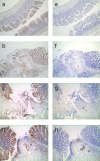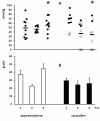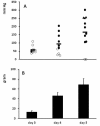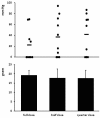Carprofen for perioperative analgesia causes early anastomotic leakage in the rat ileum
- PMID: 23270317
- PMCID: PMC3582476
- DOI: 10.1186/1746-6148-8-247
Carprofen for perioperative analgesia causes early anastomotic leakage in the rat ileum
Abstract
Background: There is increasing evidence that perioperative use of NSAIDs may compromise the integrity of intestinal anastomoses. This study aims to characterize the negative effects of carprofen on early anastomotic healing in the rat ileum.
Results: In 159 male Wistar rats an anastomosis was constructed in the ileum. In experiment 1 eighty-four rats were divided over control and experimental groups, which received daily buprenorphine or carprofen, respectively, as an analgesic and were killed on day 1, 2 or 3 after surgery. In experiment 2 three groups of 15 rats received carprofen either immediately after surgery or with a delay of 1 or 2 days. Animals were killed after 3 days of carprofen administration. In experiment 3 three groups of 10 rats received different doses (full, half or quarter) of carprofen from surgery. In significant contrast to buprenorphine, which never did so, carprofen induced frequent signs of anastomotic leakage, which were already present at day 1. If first administration was delayed for 48 hours, the leakage rate was significantly reduced (from 80 to 20%; p = 0.0028). Throughout the study, the anastomotic bursting pressure was lowest in animals who displayed signs of anastomotic leakage. Loss of anastomotic integrity did not coincide with reduced levels of hydroxyproline or increased activity of matrix metalloproteinases.
Conclusions: Carprofen interferes with wound healing in the rat ileum at a very early stage. Although the mechanisms responsible remain to be fully elucidated, one should be aware of the potential of NSAIDs to interfere with the early phase of wound repair.
Figures





Similar articles
-
Perioperative pain relief by a COX-2 inhibitor affects ileal repair and provides a model for anastomotic leakage in the intestine.Surg Innov. 2013 Apr;20(2):113-8. doi: 10.1177/1553350612442793. Epub 2012 Apr 24. Surg Innov. 2013. PMID: 22532618
-
Safety and Efficacy of Alginate Adhesion Barrier Gel in Compromised Intestinal Anastomosis.Surg Infect (Larchmt). 2017 Aug/Sep;18(6):670-675. doi: 10.1089/sur.2016.086. Epub 2017 Jun 5. Surg Infect (Larchmt). 2017. PMID: 28581895
-
Postoperative non-steroidal anti-inflammatory drugs and colorectal anastomotic leakage. NSAIDs and anastomotic leakage.Dan Med J. 2012 Mar;59(3):B4420. Dan Med J. 2012. PMID: 22381097 Review.
-
Diclofenac causes more leakage than naproxen in anastomoses in the small intestine of the rat.Int J Colorectal Dis. 2013 Sep;28(9):1209-16. doi: 10.1007/s00384-013-1652-6. Epub 2013 Feb 10. Int J Colorectal Dis. 2013. PMID: 23397591
-
Risk of anastomotic leakage with use of NSAIDs after gastrointestinal surgery.Int J Colorectal Dis. 2011 Dec;26(12):1501-9. doi: 10.1007/s00384-011-1285-6. Epub 2011 Aug 11. Int J Colorectal Dis. 2011. PMID: 21833507 Review.
References
-
- Richardson CA, Flecknell PA. Anaesthesia and post-operative analgesia following experimental surgery in laboratory rodents: are we making progress? Altern Lab Anim. 2005;33(2):119–127. - PubMed
-
- van der Vijver RJ, van Laarhoven CJ, de Man BM, Lomme RM, Hendriks T. Perioperative Pain Relief by a COX-2 Inhibitor Affects Ileal Repair and Provides a Model for Anastomotic Leakage in the Intestine. Surg Innov. 2012. epub ahead of print. - PubMed
MeSH terms
Substances
LinkOut - more resources
Full Text Sources

